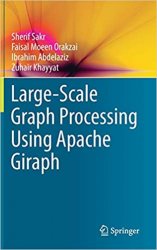 Название: Large-Scale Graph Processing Using Apache Giraph
Название: Large-Scale Graph Processing Using Apache Giraph Автор: Sherif Sakr, Faisal Moeen Orakzai
Издательство: Springer
Год: 2017
Страниц: 214
Язык: английский
Формат: pdf (true)
Размер: 10.1 MB
This book takes its reader on a journey through Apache Giraph, a popular distributed graph processing platform designed to bring the power of big data processing to graph data. Designed as a step-by-step self-study guide for everyone interested in large-scale graph processing, it describes the fundamental abstractions of the system, its programming models and various techniques for using the system to process graph data at scale, including the implementation of several popular and advanced graph analytics algorithms.
Apache Giraph is an open-source system for Pregel-like, large-scale graph data processing. It has a global and growing user community and is thus an increasingly popular system for managing and analyzing graph data. This book provides a step-by-step guidance to data management professionals, students, and researchers who are looking to understand and use Apache Giraph. It guides the reader through the details of installing and configuring the system. It offers a detailed description of the programming model and related aspects. And it offers a step-by-step coverage of the implementation of several popular, as well as advanced, graph analytics algorithms, covering also related optimization details.
The book is organized as follows: Chapter 1 starts by providing a general background of the big data phenomenon and a general introduction to the Apache Giraph system, its abstraction, programming model and design architecture. Next, chapter 2 focuses on Giraph as a platform and how to use it. Based on a sample job, even more advanced topics like monitoring the Giraph application lifecycle and different methods for monitoring Giraph jobs are explained. Chapter 3 then provides an introduction to Giraph programming, introduces the basic Giraph graph model and explains how to write Giraph programs. In turn, Chapter 4 discusses in detail the implementation of some popular graph algorithms including PageRank, connected components, shortest paths and triangle closing. Chapter 5 focuses on advanced Giraph programming, discussing common Giraph algorithmic optimizations, tunable Giraph configurations that determine the system’s utilization of the underlying resources, and how to write a custom graph input and output format. Lastly, chapter 6 highlights two systems that have been introduced to tackle the challenge of large scale graph processing, GraphX and GraphLab, and explains the main commonalities and differences between these systems and Apache Giraph.
This book serves as an essential reference guide for students, researchers and practitioners in the domain of large scale graph processing. It offers step-by-step guidance, with several code examples and the complete source code available in the related github repository. Students will find a comprehensive introduction to and hands-on practice with tackling large scale graph processing problems using the Apache Giraph system, while researchers will discover thorough coverage of the emerging and ongoing advancements in big graph processing systems.
Скачать Large-Scale Graph Processing Using Apache Giraph